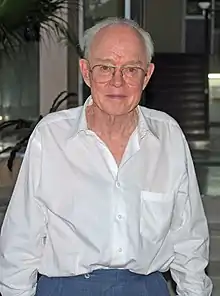Eugene N. Parker
Eugene Newman Parker (* 10. Juni 1927 in Houghton, Michigan) ist ein US-amerikanischer Astrophysiker.

Biografie
Parker studierte an der Michigan State University (Bachelor-Abschluss 1948) und wurde 1951 am Caltech promoviert. Danach war er Instructor an der University of Utah und ab 1953 Forschungsassistent von Walter Elsasser in Utah. 1955 wurde er Forschungsassistent von John Alexander Simpson an der University of Chicago. 1957 wurde er dort Assistant Professor und 1962 Professor in der Physik-Fakultät und am Enrico Fermi Institute. 1967 wechselte er an die Fakultät für Astronomie und Astrophysik. 1995 ging er in den Ruhestand.
1967 wurde er Mitglied der National Academy of Sciences; 1970 wurde er in die American Academy of Arts and Sciences gewählt.
Seine Forschungen betreffen vor allem den Sonnenwind (Parker führte diesen Begriff ein), die Magnetfelder von Erde und Sonne und deren komplexe Wechselwirkungen. 1956 war er einer der Entwickler der Rekonnexions-Theorie, 1959 hat er die englische Bezeichnung solar wind eingeführt und eine magnetohydrodynamische Theorie zur Beschreibung des Sonnenwindes vorgeschlagen.
Die Parkerspirale als Form der heliosphärischen Stromschicht und die Raumsonde Parker Solar Probe[1] sind nach ihm benannt.
Werke
- Parker, E.N.: Conversations on electric and magnetic fields in the cosmos, Princeton University Press 2007
- Parker, E.N.: Interplanetary dynamic Processes, Interscience 1963
- Parker, E.N.: Cosmical Magnetic Fields: Their Origin and Their Activity. Oxford & NY: Clarendon Press, 1979
- Parker, E.N.: Spontaneous current sheets in magnetic fields: with applications to stellar x-rays, Oxford University Press 1994
- Parker, E.N.: Dynamics of the Interplanetary Gas and Magnetic Fields in: Ap.J. 128, 664–76 (1958).
- Parker, E.N.: The Hydrodynamic Theory of Solar Corpuscular Radiation and Stellar Winds in: Ap.J. 132, 821–66 (1960).
Ehrungen
- 1964 Space Science Award des American Institute of Aeronautics and Astronautics
- 1969 Henry Norris Russell Lectureship
- 1978 George Ellery Hale Prize der American Astronomical Society
- 1989 National Medal of Science
- 1990 Karl-Schwarzschild-Medaille der Astronomischen Gesellschaft
- 1990 William Bowie Medal
- 1992 Goldmedaille der Royal Astronomical Society
- 1997 Bruce Medal der Astronomical Society of the Pacific
- 2003 Kyoto-Preis
- 2003 James-Clerk-Maxwell-Preis für Plasmaphysik für wesentliche Beiträge zur Astrophysik von Plasmen einschließlich der Vorhersage des Sonnenwindes, der Erklärung des solaren Dynamos, die Formulierung der Theorie magnetischer Rekonnexion und der Instabilität, die das Entkommen magnetischer Felder aus der Galaxie vorhersagt.[2]
- 2004 Der Asteroid (11756) Geneparker wurde nach ihm benannt
- 2012 Hannes-Alfvén-Preis
- 2017 Die Parker Solar Probe wurde nach ihm benannt
- 2020 Crafoord-Preis in Astronomie[3]
Einzelnachweise
- Jan Mahn: NASA benennt erste Sonnen-Mission um. In: heise online. Heise Zeitschriften Verlag, 1. Juni 2017, abgerufen am 9. August 2018.
- Laudatio auf den Maxwell Preis: "For seminal contributions in plasma astrophysics, including predicting the solar wind, explaining the solar dynamo, formulating the theory of magnetic reconnection, and the instability which predicts the escape of the magnetic fields from the galaxy.
- Crafoord-Preis 2020